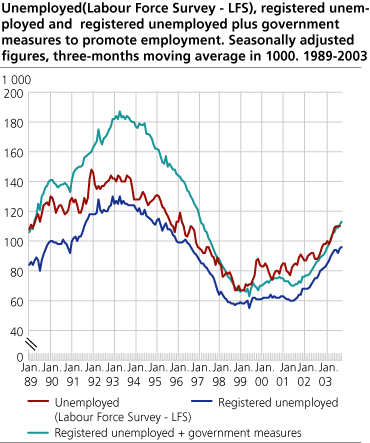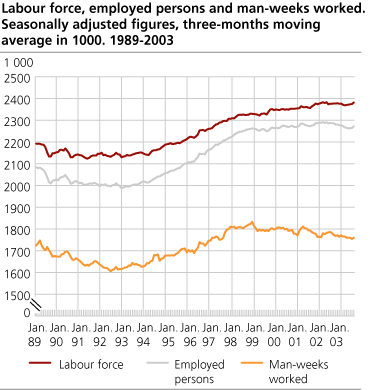Content
Published:
This is an archived release.
112 000 unemployed people
The number of unemployed people in the third quarter 2003 was 112 000, according to the Labour Force Surveys (LFS) In this quarter the unemployment was 4.7 per cent of the working force, while it was 3.8 per cent in the corresponding quarter of 2002. Over the same period the number of employed persons went down by 20 000. The new figures from the LFS also show a record low difference between male and female labour force participation.
|
Seasonally adjusted figures: No worsening in the last quarter
The employment showed small signs of improvement from the second to the third quarter 2003, according to seasonally adjusted figures from the LFS. Over the same period the unemployment stayed unchanged. Both changes are inside the margin of errors derived from the selection uncertainty of the LFS. The method of seasonally adjusting makes us more able to reveal the current development in the labour market, as an alternative to compare with the same quarter in the last year. Seasonally adjusted figures are presented in a separate article. |
The number of unemployed people in the third quarter 2003 was 112 000, according to the LFS - an increase of 21,000 from the same quarter last year. As a result, the unemployed constituted 4.7 per cent of the working force, compared to 3.8 per cent one year earlier. The unemployment has not been higher in the third quarter since 1996. Among men the unemployment was 5.1 per cent, and for women it was 4.2 per cent. The increase from the same quarter last year mainly came among men aged 25-54. Most of the growth came among people wanting a full-time job.
Unemployment in the EU and OECD: 8,0 and 7,1 per cent
The seasonally adjusted unemployment rate in Norway stayed at 4.6 per cent both in May and August 2003. In the same period the unemployment stayed unchanged at 8.0 per cent as an average in the EU member countries. The unemployment rate in the OECD-countries as a whole went down from 7.2 to 7.1 per cent. Both in May and August 2003 the unemployment rate amounted to 6.1 per cent in the USA. The unemployment rate in Sweden increased from 5.4 per cent in May to 5.5 per cent in August 2003, while it went down from 9.2 to 9.0 per cent in Finland. In the same period, unemployment remained unchanged in France and Germany. This is according to figures from OECD and Eurostat .
More under-employment
85,000 persons were under-employed in the third quarter 2003, i.e. part-time employees seeking more work - an increase by 11 000 from the same quarter last year. As a percentage of all part-time employees, this corresponds to 14.7 per cent, compared to 12.8 per cent in the third quarter 2002. Half of the under-employed people want to work full-time.
Lower male labour force participation
From the third quarter 2002 to the third quarter 2003, the male labour force participation decreased from 77.8 to 77.0 per cent. For women the participation rate stayed unchanged at about 70 per cent. The overall labour force participation has not been lower in the third quarter since 1996. The difference between male and female labour force participation has never been lower than in this . People aged 55-74, and particularly men, increased their labour force participation, while the younger groups had a reduction.
Employment decreased for men
The number of male employees went down by 19,000 from the third quarter 2002 to the third quarter 2003. For women the number of employees was unchanged. The decrease was strongest for men aged 25-54 working full-time. This group decreased by 32,000 people compared with the corresponding quarter last year. The manufacturing industries experienced the largest decrease - 21,000. Part of this development may be due to lesser use of summertime substitutes in the third quarter 2003 compared to the same quarter 2002.
Unchanged temporary employment
218,000 persons were temporary employed in the third quarter 2003, which is approximately at the same level as in the same quarter 2002. This corresponds to 10.3 per cent of all employees compared with 10.6 per cent one year before. The rate of temporary employment was highest in the primary industries, hotels and restaurants, and health and social work. In the opposite end we find financial intermediation, real estate and business activities, in addition to manufacturing.
Tables:
- Table 1 Population aged 16-74 in the labour force, man-weeks worked, registered unemployed persons and persons employed by government measures. 1000 and per cent
- Table 2 Population aged 16-74 år in the labour force, employed persons and unemployed persons by sex (LFS). 1000 and per cent
- Table 3 Persons in the labour force and employed persons by age and sex (LFS). 1 000 and per cent
- Table 4 Population aged 16-74, employed persons by settled/usual working hours per week(1) and unemployed persons by age and sex (LFS). 1000
- Table 5 Persons in the labour force by age and sex. 1000 and as per cent of all in each group
- Table 6 Employed persons by sex and settled/usual working hours pr week (LFS). 1 000
- Table 7 Population aged 16-74 by main activity, part-time employment1 and age (LFS). 1 000
- Table 8 Employed persons by major industry division. 1000
- Table 9 Number of man-hours worked per week1, by industry division (LFS). 1 000
- Table 10 Employed persons,total, and employed persons at work by status and sex. Number of man-hours worked1 and actual working hours per week (LFS)
- Table 11 Population aged 16-74, employed persons, temporary absence from work and reason for absence, by sex(1). 1000 and per cent
- Table 12 Employees with temporary jobs, by major industry division (LFS). 1000 and as per cent of all employees
- Table 13 Unemployed persons by sex and age (LFS). 1000 and per cent
- Table 14 Unemployed persons by duration of job search (LFS). 1000 and per cent
- Table 15 Unemployed persons by main activity (LFS). 1 000
- Table 16 Unemployed and underemployed persons, by sex and desired working hours per week. Number of man-weeks (of 37,5 hours) supplied (LFS). 1000
- Table 17 Employment and unemployment for persons aged 16-74 years, seasonally adjusted, three-months moving average. Absolute figures in 1000 and unemployed persons in per cent of the labour force.
- Table 18 Persons in the labour force by sex and region (LFS). 1 000 and in per cent of total
- Table 19 Employed persons by sex and region (LFS). 1 000
- Table 20 Employed persons by sex and regions (LFS) as per cent of all inn each group
- Table 21 Employed persons by some major industry division and region (LFS). 1997-2002. 1 000
Contact
-
Arbeidsmarked og lønn
E-mail: arbeidsmarked@ssb.no
-
Erik Herstad Horgen
E-mail: erik.horgen@ssb.no
tel.: (+47) 93 08 68 62
-
Håvard Hungnes Lien
E-mail: havard.lien@ssb.no
tel.: (+47) 40 90 26 06


